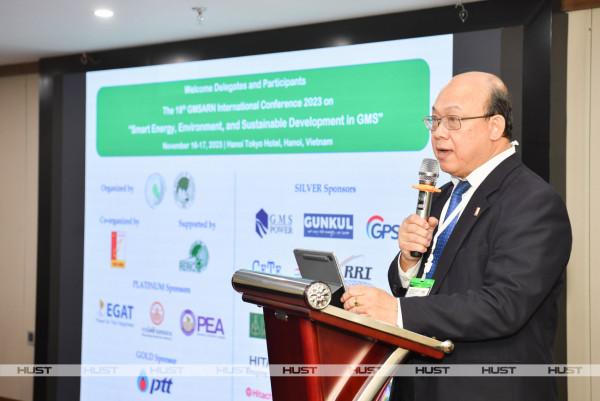
Assoc. Prof. Chu Manh Hoang (left cover) and his students with a high-resolution optical microscope system sponsored by the SAHEP Project
To engrave an object, you can hold, rotate, cut, and engrave it freely. What about engraving a micro/nano-sized material? Do you need someone with super sharp eyes and skillful hands? NO! Scientists use special tools with tiny engraving cutters.
In Vietnam, Assoc. Prof. Chu Manh Hoang – researcher at the International Training Institute in Materials Science (HUST) has successfully made plasmonic 2D materials based on an application-oriented mechanical engraving in biomedical sensors, as a premise for the research and development of mechanical engraving systems in the fabrication of micro/nanostructures. The purpose is to replace machines with limited access in Vietnam due to their huge cost.
Premise study for the development of mechanical engraving systems in the fabrication of micro/nanostructures
Assoc. Prof. Chu Manh Hoang is an engineer in Electronic Materials and holds a master's degree in Materials Science, HUST. In 2011, he successfully defended his doctoral thesis in the field of Mechatronics-Optronics-Electronics Microsystems, at Tohoku University (Japan), and worked in several laboratories abroad before returning to HUST. Currently, he is one of the few scientists in Vietnam who is well-trained in micro-mechanical technology.

Assoc. Prof. Chu Manh Hoang attended the 11th International Conference on Photonics & Applications (Hoa Binh, 2020)
His research project has been implemented since 2017 and generated some initial results. With support from the World Bank’s SAHEP Project, his team continues to work in this research direction. The team aims to successfully fabricate plasmonic 2D materials based on mechanical engraving with application orientation in biomedical sensors.
Mechanical engraving technology is to use sharp cutters to carve materials to create patterns with micro/nanoscale, very small scales. In Vietnam, there is little research on manufacturing materials on a microscopic scale. The research team led by Assoc. Prof. Chu Manh Hoang aimed at developing tools at the micro/nanoscale, thus creating micro-molds to produce Plasmonic 2D materials.
Plasmonics is currently a very "hot" field with many applications in biomedical sensors, environmental sensors, solar cells... “In Vietnam, the plasmonic research is mainly in surface materials, disordered two-dimensional materials. Our research project fabricates ordered plasmonic 2D materials with controllable scales and the ability to create different shapes like square, round…” – Assoc. Prof. Hoang said.
According to Assoc. Prof. Hoang, the challenge of the project is researching and manufacturing molds at a micro/nanoscale. For example, when milling a knife, it can be grasped, rotated, and seen during fabrication. But the micro-scaled mold cannot be grasped, rotated, or seen with the naked eye.
The research team has designed a microdisplacer using electrostatic attraction, precisely controlling the movement of the nano engraving cutter. This can be applied in manufacturing plasmonic nanostructured materials.

Assoc. Prof. Chu Manh Hoang (middle) with fellow researchers at their Ph.D. thesis defense at HUST
The research topic is interdisciplinary: Mechatronics, Physics, and Materials. With the support from SAHEP of 130 million VND, after 1 year of implementation, the research team has worked very effectively: 1 ISI paper (SCIE, Q3), 2 presentations at international conferences, 1 ESCI paper (Q3) accepted for publication (with proof), and 2 book chapters. The research results on the topic have been used in graduate training.
“SAHEP helps us be more proactive in research implementation”
According to Assoc. Prof. Chu Manh Hoang, the funding from the SAHEP Project has helped scientists take initiatives in the research and procurement of equipment, materials, and chemicals. The equipment used the most during the research was the High-Resolution Optical Microscope, which was purchased from the SAHEP’s support fund.
With more advanced equipment, the team can observe microscopic objects and actively check the engraving structure immediately for further correction. This device is also used by students in laboratory classes.
To fabricate micro/nanostructures, the team uses specialized machines such as photolithography, dry etching, wet etching, sputtering machines, oxidation furnace, high-resolution optical microscopes, and scanning electron microscope... At the International Training Institute in Materials Science, the machines under the SAHEP project arrived in turn, meeting the dire needs of HUST lecturers and students in training and research.
Assoc. Prof. Chu Manh Hoang said the group will register some patents soon. However, to be widely applied in the industry, this topic needs more time and long-term investment. “We will continue to develop into a complete manufacturing technology,” Assoc. Prof. Chu Manh Hoang affirmed.
“Now that we have laboratory equipment from SAHEP and some equipment invested in previous projects, we can measure samples right at the University, saving lots of time and effort but still ensuring high efficiency.” – Assoc. Prof. Chu Manh Hoang.
Communication and Branding Office
Author: Hà Kim
Newer articles
Older articles
 Hanoi University of Science And Technology And 4...
Hanoi University of Science And Technology And 4...
 HUST promotes partnerships with leading universities in the...
HUST promotes partnerships with leading universities in the...
 HUST co-hosted the 18th GMSARN Conference, fostering...
HUST co-hosted the 18th GMSARN Conference, fostering...
 Strategic Partnership Forges Between Hanoi University Of...
Strategic Partnership Forges Between Hanoi University Of...
 HUST President Pays Visits To Korean Academic & Industrial...
HUST President Pays Visits To Korean Academic & Industrial...
 POSCO TJ Foundation Awarded Scholarship To Hust Students
POSCO TJ Foundation Awarded Scholarship To Hust Students
 HUST advances staff capacity through "EQUIP" Project in...
HUST advances staff capacity through "EQUIP" Project in...
 From adversity to acclaim: The resilient journey of Assoc....
From adversity to acclaim: The resilient journey of Assoc....
 HUST Promotes Business Collaboration In Logistics And...
HUST Promotes Business Collaboration In Logistics And...
 HUST's imprint at Vietnam International Innovation Expo 2023
HUST's imprint at Vietnam International Innovation Expo 2023